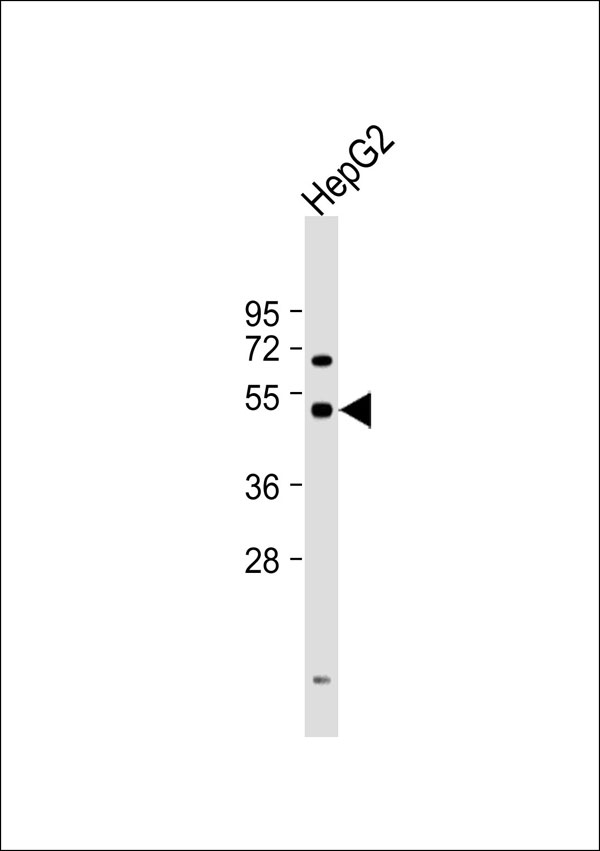Cytochrome P450 2W1 Antibody
Purified Rabbit Polyclonal Antibody (Pab)
- SPECIFICATION
- CITATIONS
- PROTOCOLS
- BACKGROUND

Application
| WB |
|---|---|
| Primary Accession | Q8TAV3 |
| Reactivity | Human |
| Host | Rabbit |
| Clonality | Polyclonal |
| Calculated MW | 54 KDa |
| Antigen Region | 311-360 aa |
| Gene ID | 54905 |
|---|---|
| Dilution | WB~~ 1:1000 |
| Format | Rabbit IgG in phosphate buffered saline , pH 7.4, 150mM NaCl, 0.09% (W/V) sodium azide and 50% glycerol |
| Storage | Store at -20 °C.Stable for 12 months from date of receipt |
| Name | CYP2W1 {ECO:0000303|PubMed:26936974, ECO:0000312|HGNC:HGNC:20243} |
|---|---|
| Function | A cytochrome P450 monooxygenase that may play a role in retinoid and phospholipid metabolism (PubMed:22591743, PubMed:26936974). Catalyzes the hydroxylation of saturated carbon hydrogen bonds. Hydroxylates all trans-retinoic acid (atRA) to 4- hydroxyretinoate and may regulate atRA clearance. Other retinoids such as all-trans retinol and all-trans retinal are potential endogenous substrates (PubMed:26936974). Catalyzes both epoxidation of double bonds and hydroxylation of carbon hydrogen bonds of the fatty acyl chain of 1-acylphospholipids/2-lysophospholipids. Can metabolize various lysophospholipids classes including lysophosphatidylcholines (LPCs), lysophosphatidylinositols (LPIs), lysophosphatidylserines (LPSs), lysophosphatidylglycerols (LPGs), lysophosphatidylethanolamines (LPEs) and lysophosphatidic acids (LPAs) (PubMed:22591743). Has low or no activity toward 2-acylphospholipids/1-lysophospholipids, diacylphospholipids and free fatty acids (PubMed:26936974, PubMed:22591743). May play a role in tumorigenesis by activating procarcinogens such as aflatoxin B1, polycyclic aromatic hydrocarbon dihydrodiols and aromatic amines (PubMed:20805301, PubMed:16551781, PubMed:24278521). Mechanistically, uses molecular oxygen inserting one oxygen atom into a substrate, and reducing the second into a water molecule, with two electrons provided by NADPH via cytochrome P450 reductase (CPR; NADPH-ferrihemoprotein reductase) (PubMed:22591743, PubMed:26936974). |
| Cellular Location | Endoplasmic reticulum lumen. Cell membrane. Microsome membrane. Note=About 8% are expressed on the cell surface. |
| Tissue Location | Very low levels are detected in fetal and adult tissues. Highly expressed in several tumor samples, in particular colon and adrenal tumors. |

Thousands of laboratories across the world have published research that depended on the performance of antibodies from Abcepta to advance their research. Check out links to articles that cite our products in major peer-reviewed journals, organized by research category.
info@abcepta.com, and receive a free "I Love Antibodies" mug.
Provided below are standard protocols that you may find useful for product applications.
Background
Seems to have broad catalytic activity towards several chemicals, including polycyclic aromatic hydrocarbon dihydrodiols and aromatic amines (PubMed:16551781, PubMed:24278521). Actives also in the metabolism of indoline substrates and is able to activate aflatoxin B1 into cytotoxic products (PubMed:20805301). Furthermore, it seems to be involved in the oxydation of lysophospholipids and fatty acids (PubMed:22591743).
References
Hillier L.W.,et al.Nature 424:157-164(2003).
Karlgren M.,et al.Biochem. Biophys. Res. Commun. 341:451-458(2006).
Wu Z.L.,et al.Mol. Pharmacol. 69:2007-2014(2006).
Gomez A.,et al.Mol. Pharmacol. 78:1004-1011(2010).
Eun C.Y.,et al.Toxicol. Res. 26:171-175(2010).
If you have used an Abcepta product and would like to share how it has performed, please click on the "Submit Review" button and provide the requested information. Our staff will examine and post your review and contact you if needed.
If you have any additional inquiries please email technical services at tech@abcepta.com.













 Foundational characteristics of cancer include proliferation, angiogenesis, migration, evasion of apoptosis, and cellular immortality. Find key markers for these cellular processes and antibodies to detect them.
Foundational characteristics of cancer include proliferation, angiogenesis, migration, evasion of apoptosis, and cellular immortality. Find key markers for these cellular processes and antibodies to detect them. The SUMOplot™ Analysis Program predicts and scores sumoylation sites in your protein. SUMOylation is a post-translational modification involved in various cellular processes, such as nuclear-cytosolic transport, transcriptional regulation, apoptosis, protein stability, response to stress, and progression through the cell cycle.
The SUMOplot™ Analysis Program predicts and scores sumoylation sites in your protein. SUMOylation is a post-translational modification involved in various cellular processes, such as nuclear-cytosolic transport, transcriptional regulation, apoptosis, protein stability, response to stress, and progression through the cell cycle. The Autophagy Receptor Motif Plotter predicts and scores autophagy receptor binding sites in your protein. Identifying proteins connected to this pathway is critical to understanding the role of autophagy in physiological as well as pathological processes such as development, differentiation, neurodegenerative diseases, stress, infection, and cancer.
The Autophagy Receptor Motif Plotter predicts and scores autophagy receptor binding sites in your protein. Identifying proteins connected to this pathway is critical to understanding the role of autophagy in physiological as well as pathological processes such as development, differentiation, neurodegenerative diseases, stress, infection, and cancer.


